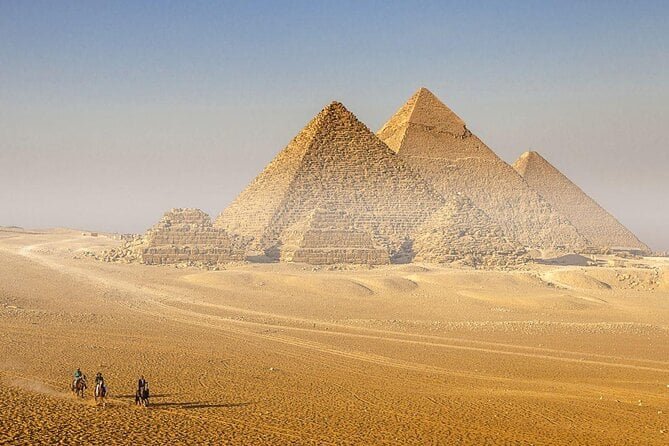
Egypt, situated in the northeastern corner of Africa, is one of the world’s oldest and most historically significant civilizations. The country’s enduring legacy is most visibly preserved in its ancient structures and institutions—particularly the Pyramids of Giza and its extensive array of museums that document over 5,000 years of human history. These sites offer visitors direct insight into the achievements, belief systems, and daily life of one of the greatest ancient cultures the world has ever known.
This document outlines the historical significance, architectural features, and educational value of Egypt’s pyramids and museums, focusing on how these institutions contribute to global understanding of ancient civilizations.
The Pyramids of Egypt: Architectural and Cultural Legacy
The Pyramids of Giza
Located on the Giza Plateau near Cairo, the Pyramids of Giza are among the most recognized and studied structures in human history. The complex includes:
- The Great Pyramid of Khufu (Cheops): Completed around 2560 BCE, it originally stood at approximately 146.6 meters (481 feet). It is the largest pyramid in Egypt and the only surviving structure of the original Seven Wonders of the Ancient World.
- The Pyramid of Khafre: Slightly smaller than Khufu’s, it is notable for appearing taller due to its elevated location and the presence of casing stones near its summit.
- The Pyramid of Menkaure: The smallest of the three, yet significant due to its unique internal structure and complex of subsidiary pyramids.
- The Great Sphinx of Giza: Located near Khafre’s pyramid, this limestone statue with a lion’s body and a human head is believed to represent King Khafre. It measures 73 meters long and 20 meters high.
These structures served as tombs for the pharaohs and were part of larger mortuary complexes. Their construction demonstrates remarkable knowledge of mathematics, astronomy, and engineering. The alignment of the pyramids with celestial bodies and the precision of their dimensions continue to be topics of academic interest.
Construction Techniques and Labor
Archaeological evidence indicates that the pyramids were built using a massive workforce of skilled laborers, not slaves as often portrayed in popular media. Workers were organized into specialized teams, and the construction process involved moving massive limestone and granite blocks using sledges, ramps, and simple tools. The logistics of food, shelter, and medical care for the workers also reflect a highly organized society.
Cultural and Religious Function
The pyramids were integral to the Egyptian religious belief in the afterlife. Each pyramid was aligned with celestial phenomena and included passages and chambers to assist the pharaoh’s journey to the afterlife. The mortuary temples attached to the pyramids were used for rituals performed by priests long after the pharaoh’s death.
Museums in Egypt: Custodians of Ancient History
Beyond the physical monuments, Egypt’s numerous museums play a crucial role in preserving and interpreting its historical and cultural heritage. These institutions house artifacts ranging from monumental sculptures to everyday items used by ancient Egyptians. They serve not only as educational centers but also as resources for researchers and historians.
The Egyptian Museum in Cairo
The Egyptian Museum in Cairo, also known as the Museum of Egyptian Antiquities, was established in 1902 and is located in Tahrir Square. It houses over 120,000 items, including:
- The Treasures of Tutankhamun: Discovered in 1922 in the Valley of the Kings, these include the pharaoh’s gold mask, jewelry, chariots, and ceremonial items.
- Royal Mummies: Several well-preserved royal mummies, including those of Ramses II and Seti I, are housed in climate-controlled environments.
- Sculptures and Statues: Items range from colossal statues of pharaohs to intricately carved representations of deities and officials.
- Funerary Objects: These include canopic jars, coffins, amulets, and other items associated with burial rituals.
The museum’s chronological layout and detailed labels provide visitors with a comprehensive understanding of the Old, Middle, and New Kingdoms.
The Grand Egyptian Museum (GEM)
The Grand Egyptian Museum, expected to fully open in the near future near the Giza Plateau, will become the largest archaeological museum in the world. It aims to consolidate, conserve, and display over 100,000 artifacts, including the complete Tutankhamun collection. The facility is equipped with state-of-the-art conservation labs, digital archives, and educational facilities. Its strategic location near the pyramids enhances its role in promoting heritage tourism.
The National Museum of Egyptian Civilization (NMEC)
Located in Fustat, Old Cairo, the National Museum of Egyptian Civilization offers a comprehensive overview of Egyptian civilization from prehistoric times to the modern era. The museum’s highlight is the Royal Mummies Hall, where visitors can view 20 mummies of ancient Egyptian kings and queens.
The NMEC organizes its exhibitions thematically, covering society, governance, belief systems, and knowledge in ancient Egypt. It also places Egyptian history within broader African and Mediterranean contexts.
Luxor Museum and Mummification Museum
Located in Upper Egypt, the Luxor Museum presents artifacts primarily from the Theban necropolis and temples. It includes statues, stelae, and items from tombs, all displayed with detailed contextual information.
Adjacent to it, the Mummification Museum provides insight into the religious and scientific aspects of mummification. Exhibits include tools, chemical substances, and examples of preserved human and animal remains.
Educational and Scientific Importance
Preservation and Research
Egyptian museums play a vital role in the preservation of artifacts threatened by environmental degradation, looting, and illegal trade. Through partnerships with international institutions, Egypt has implemented conservation techniques and digitization efforts to protect its cultural heritage.
Scientific research, including CT scans and DNA analysis of mummies, has provided new information about ancient health, diet, genealogy, and causes of death. These studies are instrumental in correcting historical narratives and understanding ancient Egyptian society in more precise terms.
Contributions to Historical Knowledge
The artifacts and inscriptions preserved in museums offer valuable data on ancient Egyptian governance, economy, religion, language, and daily life. For instance:
- Administrative papyri reveal details about taxation, resource distribution, and legal disputes.
- Religious texts such as the Book of the Dead illustrate beliefs about the afterlife and moral conduct.
- Household items and clothing give insight into the social hierarchy and material culture of various classes.
These findings contribute to comparative studies of early civilizations and inform interdisciplinary fields such as archaeology, anthropology, and art history.
Visitor Experience and Cultural Impact
Accessibility and Interpretation
Most Egyptian museums provide guided tours, audio guides, and multilingual exhibits to accommodate international visitors. Interactive displays and reconstructed scenes enhance educational value, particularly for younger audiences.
Virtual tours and online databases have increased global access to Egyptian heritage, allowing scholars and enthusiasts worldwide to explore collections remotely. This digital outreach supports educational programs and cultural diplomacy.
Tourism and Economic Contribution
The pyramids and museums are central to Egypt’s tourism sector, which significantly contributes to the national economy. Tourism-related infrastructure, including transportation, hospitality, and security, is concentrated around these cultural assets.
Efforts to improve site preservation, visitor safety, and accessibility have made Egypt a focal point for heritage tourism. International cooperation and UNESCO recognition further reinforce its global cultural significance.
Challenges and Preservation Efforts
Environmental Threats
Pollution, urban expansion, and climate change pose risks to ancient monuments and artifacts. Acid rain, humidity, and sandstorms accelerate the deterioration of stone and pigment. Museums invest in climate control systems and protective casing to mitigate such effects.
Illegal Excavation and Smuggling
The illicit antiquities trade remains a concern. The Egyptian government, in collaboration with international law enforcement and cultural organizations, continues to recover smuggled artifacts and prosecute unauthorized excavations.
Capacity and Funding
While new institutions like GEM are well-funded and technologically advanced, smaller regional museums often face budget constraints, limited staff training, and outdated facilities. Expanding resources to all levels of the museum network is critical for sustainable preservation and education.
Conclusion
Egypt’s pyramids and ancient museums are not merely tourist attractions—they are repositories of global human history. The Pyramids of Giza serve as enduring testaments to ancient engineering and spiritual belief, while museums such as the Egyptian Museum in Cairo, the Grand Egyptian Museum, and the National Museum of Egyptian Civilization preserve and interpret the cultural achievements of ancient Egypt for present and future generations.
These sites support academic research, promote cross-cultural understanding, and contribute significantly to national development through tourism. Ongoing preservation efforts, technological integration, and international cooperation are essential to ensuring that these historical assets continue to educate and inspire the world.
By witnessing Egypt’s pyramids and exploring its museums, visitors engage directly with stories that span millennia—stories that continue to shape our understanding of civilization itself.




